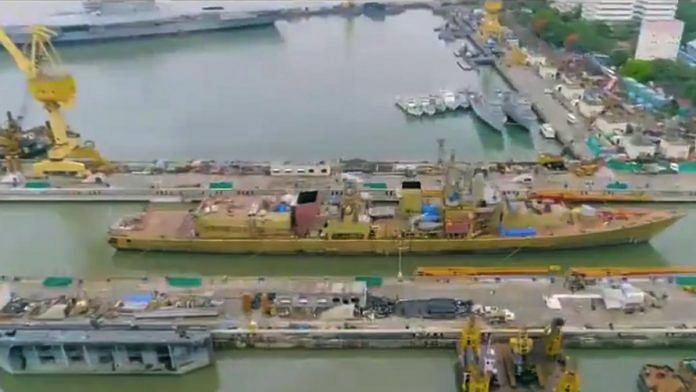New Delhi: Defence Minister Rajnath Singh will Saturday inaugurate the Indian Navy’s largest, state-of-the-art dry dock — large enough for the docking of aircraft carrier INS Vikramaditya — in Mumbai’s Naval Dockyard.
RM @rajnathsingh will tomorrow inaugurate the biggest and state of the art dry dock at the Naval Dockyard in Mumbai that is capable of berthing aircraft carrier INS Vikramaditya. Watch the video to know more about the Rs 1,320 crore project. @ThePrintIndia @indiannavy pic.twitter.com/DPAO6seesp
— Snehesh Alex Philip (@sneheshphilip) September 27, 2019
An engineering feat that cost the Navy Rs 1,320 crore, the dry dock — measuring 281 metres in length, 45 mteres in width and 16.7 metres in depth — will allow multiple ship-docking, including two submarines at the same time.
A dry dock is a berthing place to carry out repair, refuelling and maintenance of a ship. The ships have to regularly undergo essential underwater repairs which can be done only when the vessel is on a dry dock.
While the Mumbai dockyard had three existing British era dry docks, they could not accommodate an aircraft carrier which is bigger in size and displacement as compared to any regular ship.
For example, the INS Vikramaditya has a displacement of 45,000 tonnes and is twice the six of a regular frigate in length. The Shivalik class stealth frigate, also being launched Saturday by Singh, has a displacement of only 6,500 tonnes.
The new dry dock has a unique design involving construction into the sea rather than utilising the limited land available in the Naval Dockyard in Mumbai.
“It is a huge capability enhancement for the Navy. Earlier, we had to depend on the Kochi Shipyard for INS Vikramaditya which involved some waiting period since arrangements had to be made. However, the Navy will now have its own facility,” a senior Navy officer told ThePrint on condition of anonymity.
The Navy currently has dry dock facilities in Mumbai and Visakhapatnam, and a ship lift facility in Karwar. However, none could accommodate an aircraft carrier.
“There is another aircraft carrier which is under construction in Kochi. It was important to have our own dry dock of this size,” said a second Navy officer who didn’t wish to be named.
The officers said that with the new dock yard, the turnaround time for ships will increase as they won’t have to wait much for state-run shipyards and private dock yards.
The latest addition also reduces the burden on the state exchequer, sources said, adding that such docking used to cost lakhs of rupees on a per-day basis at private dockyard facilities, depending on the size of the ship and nature of works.
Also read: Swedish major SAAB pulls out of P75I race, cites ‘unbalance’ in strategic partnership policy
The engineering behind the dockyard
The new dry dock has been made with 80,000 metric tonnes of steel, equivalent to that used to build the Eiffel tower, the Navy said.
Constructed over 40 lakh-man days, the dock was built with over five lakh tonnes of concrete — one-and-a-half times the quantity of cement used for building Mumbai’s iconic Bandra-Worli sea link.
Both structures have been built by the Hindustan Construction Company.
Almost 2.23 lakh tonne silt was removed from the dock during construction, enough to construct 90 football fields.
Each of the eight powerful pumps installed can fill a tank of 10,000 cubic meter in three seconds and all the pumps together can remove 200 million litres of water in just two-and-a-half hours.
The Naval dockyard
According to Sainik Samachar, a publication of the Ministry of Defence, the dockyard in Mumbai was the first military establishment to be set up in India by the British, and has a history spanning over two-and-a-half centuries.
In 1686, the British started shifting their operations “from Surat to Bombay after they acquired it from the Portuguese and gradually developed ship-building and repair facilities” there.
“In addition to a mud basin set up in 1693-94, covered marine store houses, carpenters shed, smithy shop, offices and quarters were progressively set up. With this, the yard became a wholesome facility and this historic milestone signified the birth of the ‘Marine Yard’ in 1735,” said the defence publication.
“From building smaller ships, the yard graduated to build bigger ones. Some ships were fitted with as many as 84 guns while the largest ship built was a 2591-ton HMS Madras (renamed HMS Meanee),” it said.
Post-Independence, it was renamed the Naval Dockyard, and new facilities were set up “to meet the needs of the newer ships and submarines which were inducted into the Indian Navy”.
Also read: European defence major, Swedish firm in race to clinch deal for Navy’s missile project




Pl keep the hatches closed this time.